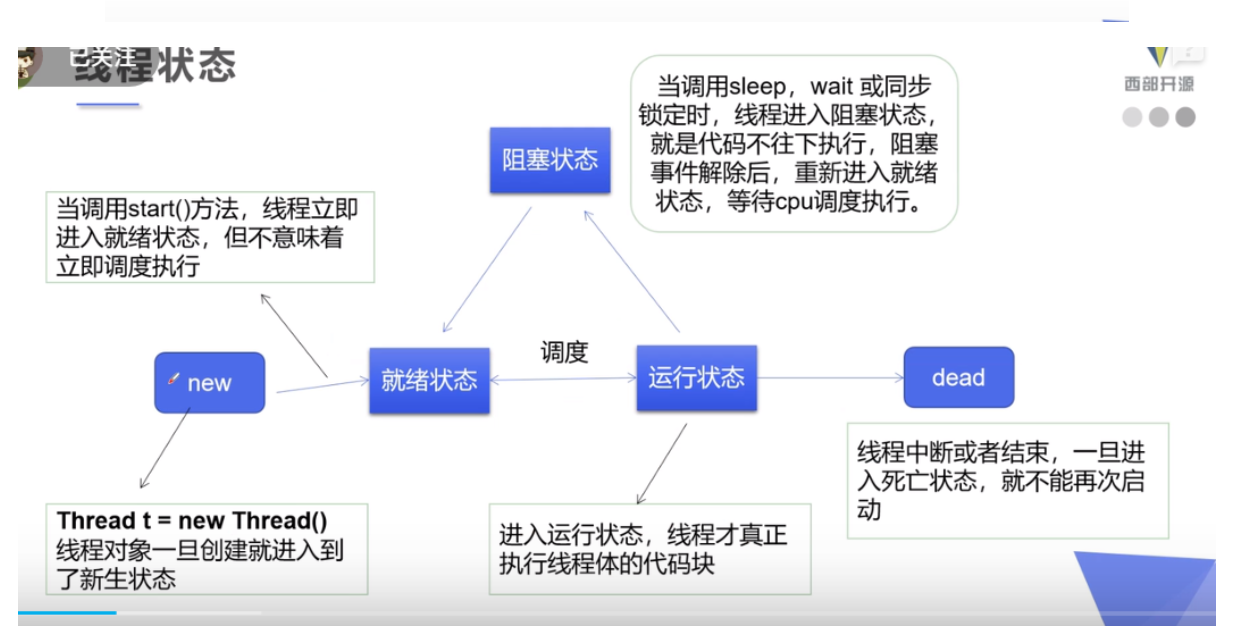1.总状态


2.线程方法:
-
setPriority(int newPriority) :更改线程优先级
-
static void sleep(long millis):在指定的毫秒数内让当前正在执行的线程休眠
-
void join():等待该线程终止
-
static void yield():暂停当前正在执行的线程对象,并执行其他线程
-
void interrupt():中断线程,别用这个方式
-
boolean isAlive():测试线程是否处于活动状态
3.停止线程
-
不推荐使用JDK提供的stop().destroy()方法。【已废弃】。
-
推荐线程自己停下来。
-
建议使用一个标志位进行终止变量当flag=false,则终止线程运行。
// 测试stop
// 1.建议线程正常停止----->利用次数,不建议死循环
// 2.建议使用标志位 ---->设置一个标志位
// 3.不推荐使用stop或者destory等过时jdk方法
public class TestStop implements Runnable{
// 1.设置一个标识位
private boolean flag = true;
4.线程休眠
-
sleep (时间)指定当前线程阻塞的毫秒数;
-
sleep存在异常InterruptedException;
-
sleep时间达到后线程进入就绪状态;
-
sleep可以模拟网络延时,倒计时等。
-
每一个对象都有一个锁,sleep不会释放锁;
// 模拟倒计时
public class TestSleep2 {
public static void main(String[] args) {
// 模拟倒计时
try {
tenDown();
} catch (InterruptedException e) {
e.printStackTrace();
}
// 打印系统时间
Date startTime = new Date(System.currentTimeMillis());//获取当前系统时间
while (true){
try {
Thread.sleep(1000);
System.out.println(new SimpleDateFormat("HH:mm:ss").format(startTime));
startTime = new Date(System.currentTimeMillis());//更新时间
} catch (InterruptedException e) {
throw new RuntimeException(e);
}
}
}
// 模拟倒计时
public static void tenDown() throws InterruptedException{
int num = 10;
while (true){
Thread.sleep(500);
System.out.println(num--);
if(num<0){
break;
}
}
}
}
5.线程礼让
-
礼让线程,让当前正在执行的线程暂停,但不阻塞
-
将线程从运行状态转为就绪状态
-
让cpu重新调度,礼让不一定成功!看CPU心情
//测试礼让线程
// 礼让不一定成功,看cpu心情
public class TestYield {
public static void main(String[] args) {
MyYield myYield = new MyYield();
new Thread(myYield,"a").start();
new Thread(myYield,"b").start();
}
}
class MyYield implements Runnable{
6.Join方法
-
Join合并线程,待此线程执行完成后,再执行其他线程,其他线程阻塞(类似插队)
// 测试join方法
public class TestJoin implements Runnable{